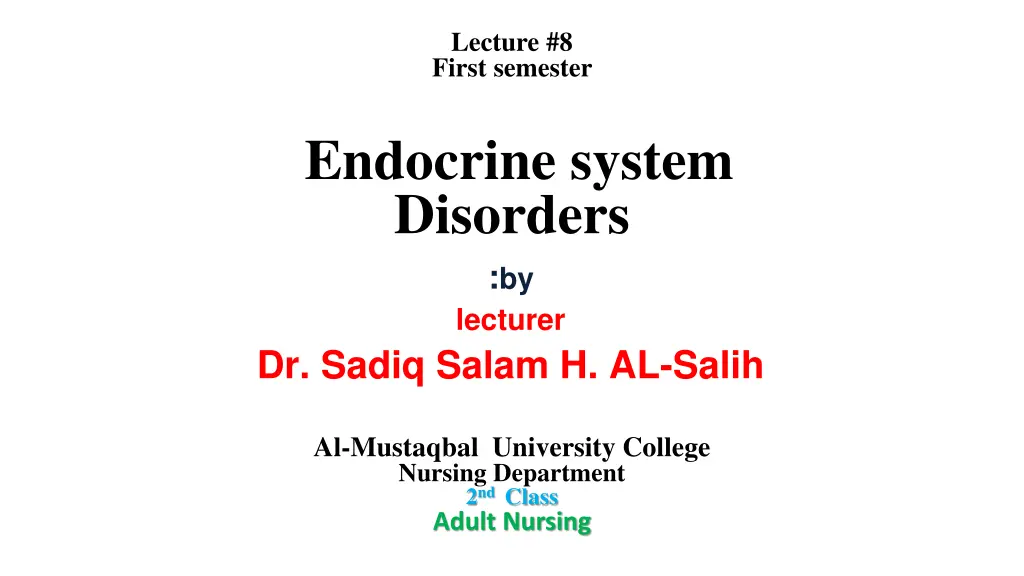
Understanding Endocrine System Disorders and Glands Function
Explore the endocrine system, its role in regulating body functions, the types of glands, and diseases like diabetes mellitus. Gain insights into the pancreas and its dual function as an endocrine and exocrine organ.
Download Presentation

Please find below an Image/Link to download the presentation.
The content on the website is provided AS IS for your information and personal use only. It may not be sold, licensed, or shared on other websites without obtaining consent from the author. If you encounter any issues during the download, it is possible that the publisher has removed the file from their server.
You are allowed to download the files provided on this website for personal or commercial use, subject to the condition that they are used lawfully. All files are the property of their respective owners.
The content on the website is provided AS IS for your information and personal use only. It may not be sold, licensed, or shared on other websites without obtaining consent from the author.
E N D
Presentation Transcript
Lecture #8 First semester Endocrine system Disorders :by lecturer Dr. Sadiq Salam H. AL-Salih Al-Mustaqbal University College Nursing Department 2nd Class Adult Nursing
The Endocrine System The endocrine system is a network of glands and hormones that regulate and control the activity of cells or organs and many important body functions. The endocrine system regulates body activities by releasing hormones (chemical messengers) into the bloodstream or through ducts , where they are carried throughout the entire body. Hormonal responses may be almost instantaneous (Sudden), or may occur days later. There is a wide variety of hormonal effects.
GLANDS A group of cells (organ) that synthesizes substances (such as hormones) for release into the bloodstream (endocrine gland) or into cavities inside the body or its outer surface (exocrine gland) There are three types of glands in our body: Endocrine glands Exocrine glands Heterocrine glands
EXOCRINE GLANDS Glands that secrete their products into body ducts, which carry the products into body cavities, the lumen of an organ, or the outer surface of the body. EXAMPLE: Sweat glands Salivary glands Mammary glands Stomach Liver
ENDOCRINE GLANDS Glands that secrete their product (hormones) directly into the bloodstream rather than through a duct. EXAMPLE: Pituitary gland Pancreas Thyroid gland Adrenal glands
HETEROCRINE GLANDS These are glands that perform both exocrine and endocrine functions. For example pancreas
THE PANCREAS The pancreas is classified as both and endocrine organ and an exocrine organ. There are three main types of cells in the pancreatic islets: (alpha) cells, which secrete glucagon (increases blood glucose levels) (beta) cells, which are the most numerous, secrete insulin(reduces blood glucose levels) (delta) cells, which secrete somatostatin( inhibits the secretion of both insulin and glucagon).
DISEASES RELATED TO INSULIN DIABETES MELLITUS It is a group of metabolic diseases in which there are high blood sugar over a prolonged period. This high blood sugar produces the symptoms of frequent urination, increased thirst, and increased hunger.
Diabetes Mellitus Type I - Insulin-Dependent Diabetes Mellitus - IDDM (10% - onset 15 yo) Type II - Non Insulin-Dependent Diabetes Mellitus"-NIDDM (90% - onset 40+) 25-30% will require insulin eventually Gestational - GDM
Diagnosis 1- Fasting Plasma Glucose (FPG) This test checks a fasting blood sugar levels. Fasting means after not having anything to eat or drink (except water) for at least 8 hours before the test. This test is usually done first thing in the morning, before breakfast. Result Fasting Plasma Glucose (FPG) Normal less than 100 mg/dl Prediabetes 100 mg/dl to 125 mg/dl Diabetes 2- Random (also called Casual) Plasma Glucose Test This test is a blood check at any time of the day when have a severe diabetes symptoms. Diabetes is diagnosed at blood sugar of greater than or equal to 200 mg/dl 3- A1C The A1C test measures average blood sugar for the past 2 to 3 months. 126 mg/dl or higher Result A1C Normal less than 5.7% Prediabetes 5.7% to 6.4% Diabetes 6.5% or higher
INCIDENCE RATE: 90% generalpopulation RISK FACTORS: 1. Age 2. Heredity 3. OBESITY becauseobese persons lack insulinreceptor binding sites 4. Sedentary lifestyle (lack of exercise, increased intake of carbohydrates) 5.Hypertension 6.Triglyceride level of 250mg/dL INCIDENCE RATE: 10% general population RISK FACTORS: 1. Age 2.Herediy 3. Autoimmunereaction 4. Related to viruses 5. Drugs a. Lasix b. Steroids
SIGNS AND SYMPTOMS: 1.Polyuria 2.Polydypsia 3.Polyphagia 4.Glucosuria 5.WEIGHT LOSS 6.Anorexia, nausea and vomiting 7.Blurring ofvision 8.Increase susceptibility to infection 9.Delayed/poor wound healing TREATMENT: 1.Insulin therapy 2.Diet 3.Exercise SIGNS ANDSYMPTOMS: 1.Usuallyasymptomatic 2.Polyuria 3.Polydypsia 4.Polyphagia 5.Glucosuria 6.WEIGHT GAIN TREATMENT: 1.Oral Hypoglycemicagents 2.Diet 3.Exercise
A. SOURCES OF INSULIN 1.Animal sources Rarely used because it can cause severe allergic reaction Derived from beef and pork 2.Human Sources Frequently used type because it has less allergic reaction 3.Artificial Compound Insulin
B. TYPES OF INSULIN 1. RAPID ACTING INSULIN(CLEAR) Regular acting insulin (IV only) Peak action is 2 4 hours 2. INTERMEDIATE ACTING INSULIN(CLOUDY) Non Protamine Hagedorn Insulin (NPH) Peak action is 8 16 hours 3. LONG ACTING INSULIN(CLOUDY) Ultra Lente Peak action is 16 24 hours
Thyroid gland ANATOMY OF THE THYROID GLAND: - The thyroid gland is situated in the neck in front of the larynx and trachea It weighs about 25g It looks like butterfly in shape Consisting of two lobes The lobes are joined by a narrow isthmus
THYROID HORMONES Tri-iodothyronine (T3): It affects almost every physiological process in the body: Growth and development, Metabolism, Body temperature,and Heart rate Thyroxin (T4): Controls development and maturation Excess thyroxin results rapid development Deficiency of thyroxin results in delayed development
All body systems are INCREASED except WEIGHT & MENSTRUATION INCREASED CNS: tremors, insomnia INCREASED VS: hypertension, tachypnea, tachycardia, hyperthermia INCREASED GI motility: DIARRHEA INCREASED appetite but with WEIGHT LOSS INCREASED metabolism causes increased perspiration w/c results to MOIST SKIN & HEAT INTOLERANCE DECREASED amenorrhea EXPOTHALMOS Pathognomonic Sign All body systems are DECREASED except WEIGHT & MENSTRUATION DECREASED CNS: drowsiness, memory losses (FORGETFULNESS) DECREASED VS: hypotension, bradypnea, bradycardia, hypothermia DECREASED GI motility: CONSTIPATION DECREASED appetite but with WEIGHT GAIN results to INCREASED SERUM CHOLESTEROL LEVELS results to, MI, CHF, STROKE DECREASED metabolism causes decreased perspiration w/c results to DRY SKIN & COLD INTOLERANCE INCREASED menorrhagia
DIAGNOSTIC TESTS: 1.Serum T3 and T4 is INCREASED 2.Thyroid Scan - reveals an ENLARGED THYROID GLAND NURSING MANAGEMENT: 1. Monitor vital signs and intake and output to determine presence of: THYROID STORM is a severe form of hyperthyroidism is characterized by severe hypertension, tachycardia, tachypnea, hyperpyrexia, altered neurologic or mental state, which frequently appears as delirium psychosis, coma NURSING MANAGEMENT FOR THYROTOXICOSIS Cool quiet environment O2 inhalation IV fluids (hypertonic) Antithyroid agents DIAGNOSTIC TESTS: 1.Serum T3 and T4 isDECREASED 2.Serum Cholesterol is INCREASED NURSING MANAGEMENT: 1.Monitor vital signs and intake and output to determine presence of: MYXEDEMA COMA is a severe form of hypothyroidism is characterized by severe hypotension, bradycardia, bradypnea ,hyponatremia, hypoglycemia leading progressive to coma. NURSING MANAGEMENT FOR MYXEDEMA COMA comfortable and warm environment Assist in mechanical ventilation Administer thyroid hormones as ordered IV fluids (isotonic)






















